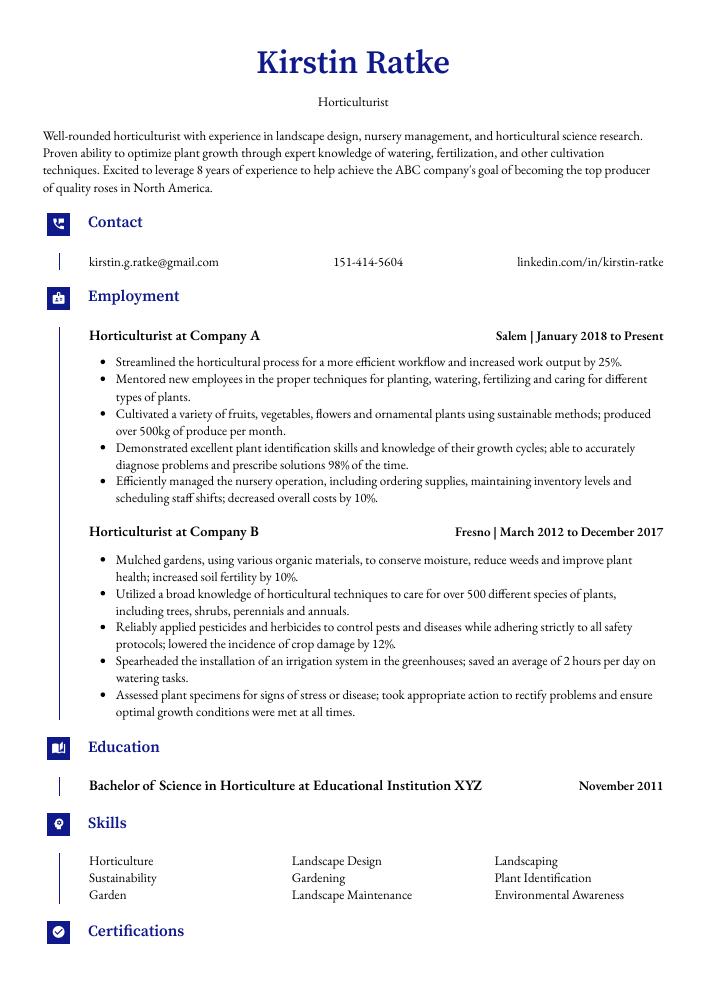Horticulturist Resume Guide
Horticulturists work with plants, including the cultivation, management, and study of them. They may work in gardens, greenhouses, orchards, nurseries, parks, or other settings. Their duties can include planting seeds or bulbs, watering and fertilizing plants, pruning shrubs and trees, and controlling pests. They also may advise homeowners or others on landscaping projects or choosing plants for their yards.
Your green thumb is the envy of everyone you know. But if you want to use your horticultural skills in a professional setting, you need to write a resume that will grab the attention of potential employers.
This guide will walk you through the entire process of creating a top-notch resume. We first show you a complete example and then break down what each resume section should look like.
Table of Contents
The guide is divided into sections for your convenience. You can read it from beginning to end or use the table of contents below to jump to a specific part.
Horticulturist Resume Sample
Kirstin Ratke
Horticulturist
[email protected]
151-414-5604
linkedin.com/in/kirstin-ratke
Summary
Well-rounded horticulturist with experience in landscape design, nursery management, and horticultural science research. Proven ability to optimize plant growth through expert knowledge of watering, fertilization, and other cultivation techniques. Excited to leverage 8 years of experience to help achieve the ABC company’s goal of becoming the top producer of quality roses in North America.
Experience
Horticulturist, Company ABC
Salem, Jan 2018 – Present
- Streamlined the horticultural process for a more efficient workflow and increased work output by 25%.
- Mentored new employees in the proper techniques for planting, watering, fertilizing and caring for different types of plants.
- Cultivated a variety of fruits, vegetables, flowers and ornamental plants using sustainable methods; produced over 500kg of produce per month.
- Demonstrated excellent plant identification skills and knowledge of their growth cycles; able to accurately diagnose problems and prescribe solutions 98% of the time.
- Efficiently managed the nursery operation, including ordering supplies, maintaining inventory levels and scheduling staff shifts; decreased overall costs by 10%.
Horticulturist, Company XYZ
Fresno, Mar 2012 – Dec 2017
- Mulched gardens, using various organic materials, to conserve moisture, reduce weeds and improve plant health; increased soil fertility by 10%.
- Utilized a broad knowledge of horticultural techniques to care for over 500 different species of plants, including trees, shrubs, perennials and annuals.
- Reliably applied pesticides and herbicides to control pests and diseases while adhering strictly to all safety protocols; lowered the incidence of crop damage by 12%.
- Spearheaded the installation of an irrigation system in the greenhouses; saved an average of 2 hours per day on watering tasks.
- Assessed plant specimens for signs of stress or disease; took appropriate action to rectify problems and ensure optimal growth conditions were met at all times.
Skills
- Horticulture
- Landscape Design
- Landscaping
- Sustainability
- Gardening
- Plant Identification
- Garden
- Landscape Maintenance
- Environmental Awareness
Education
Bachelor of Science in Horticulture
Educational Institution XYZ
Nov 2011
Certifications
Certified Horticulturist
American Society for Horticultural Science
May 2017
1. Summary / Objective
The summary or objective at the top of your resume is like a teaser – it gives the employer an outline of who you are and why you’re perfect for the job.
Here, you can showcase your best qualities. For example, you could highlight your experience in a variety of settings, from small greenhouses to large botanical gardens. You could also mention how passionate you are about plant care and education, as well as any awards or recognition you’ve received for your work.
Below are some resume summary examples:
Reliable horticulturist with 6+ years of experience in public and private gardens. Deeply familiar with plant maintenance, including watering, pruning, and propagating. Wrote the horticulture column for The Daily Gardener for 2 years. Recognized as a top performer by senior management at XYZ Gardens on 3 occasions. Seeking to join ABC Garden’s team to share my passion for horticulture and help maintain its world-renowned reputation.
Diligent horticulturist with more than 7 years of experience in cultivating, propagating, and maintaining various species of plants. Experienced in troubleshooting pest and disease problems. Achieved a 90% success rate for new plantings at XYZ Botanical Gardens. Recognized as Employee of the Month 3 times for going above and beyond expectations.
Enthusiastic and passionate horticulturist with more than 7 years of experience in plant selection, care, and maintenance. In previous roles increased sales by 18% due to expert knowledge of nursery products and effective merchandising techniques. Proven ability to develop strong relationships with customers, providing them with the required level of support to ensure satisfaction.
Professional horticulturist with 8+ years of experience in the nursery and landscape industries. Areas of expertise include plant identification, selection, and care; soil preparation; irrigation; and pesticide/herbicide application. Seeking to leverage my knowledge and passion for horticulture to improve the ABC company’s bottom line. At XYZ Nursery, increased sales by 12% through improved customer service and product education efforts.
Talented horticulturist with more than a decade of experience in landscape design and maintenance. In previous roles, created award-winning gardens that increased property value by an average of 11%. Seeking to join the team at ABC Nursery where I can put my creative flair and horticultural knowledge to good use.
Committed and detail-oriented horticulturist with more than 7 years of experience in the industry. At XYZ, focused on delivering high-quality and cost-effective horticultural services to clients across various industries. Demonstrated expertise in developing comprehensive fertilizer programs, preventing and diagnosing plant pests/diseases, and maintaining landscapes according to best practices.
Driven and passionate horticulturist with more than 10 years of experience in landscape design, installation, and maintenance. Proven ability to work independently as well as part of a team. In previous roles increased client satisfaction ratings by 27% due to excellent customer service and high-quality workmanship. Seeking an opportunity to use my skills and knowledge to contribute to the ABC team.
Passionate horticulturist with 5+ years of experience working in a greenhouse and nursery environment. Extensive knowledge of plant care, including watering, fertilizing, pruning, and pest control. Familiar with a wide range of plant varieties and their ideal growing conditions. Skilled at using various horticultural tools and equipment.
Seasoned horticulturist with 8+ years of experience in the cultivation and maintenance of plants, trees, and shrubs. In previous roles increased plant yield by 15% on average through improved irrigation techniques. Certified Arborist with a track record of maintaining the health and appearance of landscapes while adhering to budget constraints.
2. Experience / Employment
For the experience section, you will want to reverse chronologically list your employment history. This means that your most recent job should be at the top of the section.
When writing this section, it is generally best to use bullet points. This allows for an easy read, as the reader can quickly scan through and understand what you are trying to say. You also want to make sure that you are providing detail in each point, explaining what you did and any results that were achieved because of your actions.
For example: instead of saying “Grew flowers,” you might say “Grew a variety of flowers in greenhouses, yielding $XXX in revenue.”
To write effective bullet points, begin with a strong verb or adverb. Industry specific verbs to use are:
- Grew
- Planted
- Cultivated
- Pruned
- Fertilized
- Irrigated
- Weeded
- Mulched
- Harvested
- Pestered
- Sold
- Trained
- Designed
- Created
- Maintained
Other general verbs you can use are:
- Achieved
- Advised
- Assessed
- Compiled
- Coordinated
- Demonstrated
- Developed
- Expedited
- Facilitated
- Formulated
- Improved
- Introduced
- Mentored
- Optimized
- Participated
- Prepared
- Presented
- Reduced
- Reorganized
- Represented
- Revised
- Spearheaded
- Streamlined
- Structured
- Utilized
Below are some example bullet points:
- Advised clients on the best type of plants and flowers to grow in their gardens, based on climate, soil quality and amount of sunlight available.
- Optimized plant growth and yield by creating customized fertilizer blends and irrigation schedules, resulting in a 20% increase in crop production for 2 farmers.
- Structured new planting beds and redesigned existing garden layouts for 6 private residences, incorporating features such as rockeries, water features and seating areas.
- Successfully propagated over 100 different species of plants from cuttings, seeds & bulbs; developed a new hybrid rose variety that was resistant to black spot fungus.
- Introduced cost-saving initiatives that reduced watering time by 2 hours per week for the municipal flowerbeds maintained by my team; also decreased herbicide & pesticide usage by 30%.
- Coordinated the planting, care and maintenance of over 200 trees, shrubs and flower beds for a major hotel chain; ensured that the landscaping always looked its best.
- Designed new garden layouts for private residences and commercial properties, taking into account the client’s budget, style preferences and the existing terrain.
- Expedited the growth of plants using different horticultural techniques such as hydroponics, grafting and cross-breeding; successfully grew a batch of roses in half the usual time.
- Consistently provided expert advice on plant selection, soil preparation, pest control and other gardening matters to both amateur and professional clients.
- Improved yields by 20% on average through effective irrigation management and judicious use of fertilizers/pesticides; also minimized water usage by 30% through xeriscaping methods.
- Weeded flower beds, gardens and greenhouses for 7 hours every week, ensuring that only the desired plants remained.
- Trained new employees in plant identification, bed preparation and weed management techniques.
- Created a planting schedule for annuals, biennials and perennials which optimized growth and minimized maintenance requirements.
- Pruned shrubs, bushes and trees according to industry best practices; increased the health of over 50% of the plants under my care.
- Accurately identified over 200 different species of plants and flowers.
- Developed and revised horticultural plans and programs for clients, based on thorough analysis of their needs and desired results.
- Achieved a 98% success rate in executing horticultural plans and programs, as measured by client satisfaction surveys.
- Participated in continuing education courses to stay up-to-date with latest advancements in the field of horticulture.
- Thoroughly researched various plant species to determine which ones would be best suited for each individual client’s needs.
- Demonstrated excellent customer service skills when interacting with clients, providing them with expert advice and guidance on all aspects of horticulture.
- Compiled a database of over 300 plant species, their common and scientific names, growth requirements and recommended uses.
- Resourcefully sourced cheaper yet high-quality planting materials from local nurseries to save the company 20% on costs.
- Sold $4,000 worth of flowers and plants at the weekly farmer’s market stall; increased sales by 50% after introducing a loyalty card scheme.
- Grew a wide variety of fruit and vegetables in the greenhouse using different soil mixtures, mulches and irrigation systems; reduced water usage by 30%.
- Represented the horticulture club in intercollegiate flower shows; won 1st prize for 3 consecutive years with innovative garden designs featuring sustainable gardening practices.
- Proficiently managed the care of over 500 different plant species, including watering, fertilizing, pruning and repotting.
- Pestered pests off of plants using various organic and chemical methods; successfully kept all plants free from disease and infestation.
- Harvested fruits, vegetables and herbs at peak ripeness to ensure optimal flavor and freshness; averaged 15 pounds per hour during busy periods.
- Formulated new soil mixes for specific types of plants to improve drainage, reduce compacting and encourage growth; created an instructional guide for staff members to reference.
- Planted seeds, bulbs & seedlings according to spacing requirements in order to achieve desired results; increased the rate of germination by 10% on average through precise depth control & consistent moisture levels.
- Prepared and applied soil amendments, herbicides, fungicides and pesticides to horticultural crops.
- Substantially increased crop yields by implementing an effective nutrient management program.
- Irrigated crops using drip irrigation systems and monitored water usage to ensure efficient use of resources.
- Maintained records of crop production, fertilizer and pesticide applications, irrigation schedules and other important information.
- Facilitated the sale of horticultural products by grading, packing and labeling fresh produce for market.
- Fertilized and watered over 500 plants daily, ensuring that they received the nutrients needed for optimal growth.
- Independently researched and implemented new gardening methods that resulted in a 15% reduction in water usage.
- Reduced pesticide use by 50% after conducting trials to find natural alternatives that would be just as effective.
- Reorganized the nursery layout to create a more efficient workflow and save time when retrieving plants for customers.
- Presented educational seminars on plant care and propagation which increased interest in horticulture among the local community.
3. Skills
Skills that are commonly required for horticulturists include plant knowledge, gardening experience, and landscaping skills. However, the specific skills required will differ from employer to employer – this can be ascertained by reading through job postings.
It is essential to keep this in mind because of the applicant tracking systems utilized by many companies. Their role is to analyze resumes for certain characteristics (such as specific keywords), filtering out the ones they deem not to be a high-quality match for that particular job.
Besides just listing skills in this section, you should also elaborate on the most important ones in other resume sections.
Below is a list of common skills & terms:
- Agriculture
- Botany
- Ecology
- Environmental Awareness
- Garden
- Garden Design
- Gardening
- Horticulture
- Irrigation
- Landscape Design
- Landscape Maintenance
- Landscaping
- Organic Gardening
- Plant Identification
- Project Planning
- Sustainability
- Teaching
- Time Management
- Tree Planting
- Trees
4. Education
Mentioning your education on your resume will depend on how much experience you have in the field of horticulture. If you are just starting out, it is recommended to include your education below your resume objective. However, if you have been working as a horticulturist for many years and have plenty of experience to showcase, omitting the education section is perfectly fine.
If you do choose to mention your educational background, list courses and subjects related to the horticulturist job you are applying for. Examples might include “Courses included Plant Biology, Soil Science & Management, and Landscape Design” or “Designed and implemented a landscape plan for my final year project.”
Bachelor of Science in Horticulture
Educational Institution XYZ
Nov 2011
5. Certifications
Certifications provide potential employers with hard evidence that you have the skills and knowledge required to excel in a given field. They also show that you are proactive in keeping your industry knowledge up-to-date.
If you have any horticulture-related certifications, including them in this section of your resume will demonstrate to potential employers that you are indeed qualified for the job.
Certified Horticulturist
American Society for Horticultural Science
May 2017
6. Contact Info
Your name should be the first thing a reader sees when viewing your resume, so ensure its positioning is prominent. Your phone number should be written in the most commonly used format in your country/city/state, and your email address should be professional.
You can also choose to include a link to your LinkedIn profile, personal website, or other online platforms relevant to your industry.
Finally, name your resume file appropriately to help hiring managers; for Kirstin Ratke, this would be Kirstin-Ratke-resume.pdf or Kirstin-Ratke-resume.docx.
7. Cover Letter
Writing a cover letter is an opportunity to elaborate on the information in your resume and expand on why you’re a good match for the role you’re applying for. It should be 2 to 4 paragraphs long, and include additional details about your skills, experience and qualifications.
While cover letters aren’t always required, they can give you a chance to stand out from other candidates who are applying for the same job. If you take the time to write a well-crafted letter, it could be just what puts you ahead of the competition.
Below is an example cover letter:
Dear Liza,
I am writing to apply for the position of Horticulturist at your company. With a degree in horticulture and three years of professional experience, I am confident I would be a valuable asset to your team.
In my current role as Assistant Horticulturist at [company name], I work closely with the head horticulturist to maintain the grounds and gardens. I have developed strong plant identification and propagation skills, as well as expertise in using various tools and equipment. In addition, I have experience leading teams of workers on projects such as planting new gardens or caring for existing ones.
I am passionate about horticulture and take great pride in my work. My attention to detail ensures that all plants are healthy and look their best. I am also always willing to lend a helping hand wherever needed, whether it’s teaching others how to propagate plants or providing advice on which type of plant would be best suited for a particular area.
I believe I would make an excellent addition to your team and look forward to discussing this opportunity with you further. Thank you for your time and consideration; please do not hesitate to contact me if you have any questions whatsoever.
Sincerely,
[Your name]
Horticulturist Resume Templates
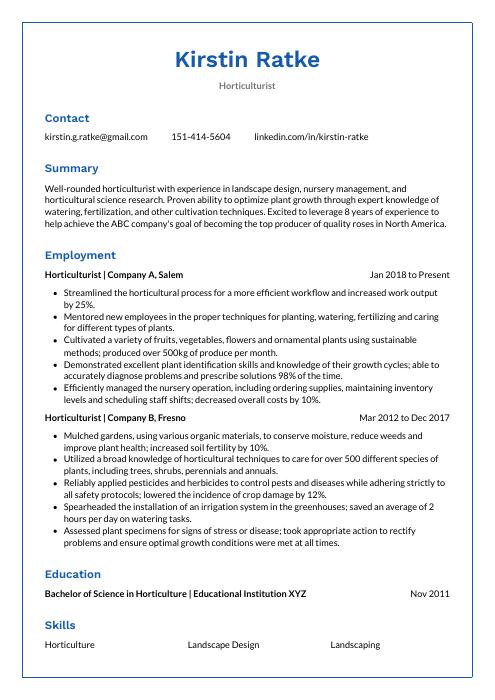 Markhor
Markhor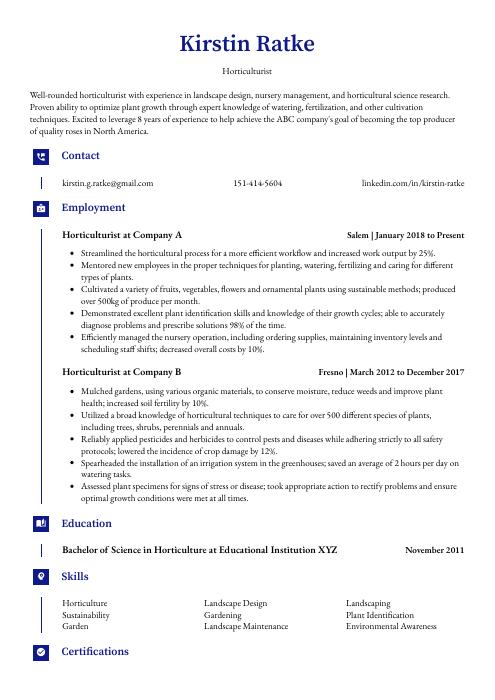 Gharial
Gharial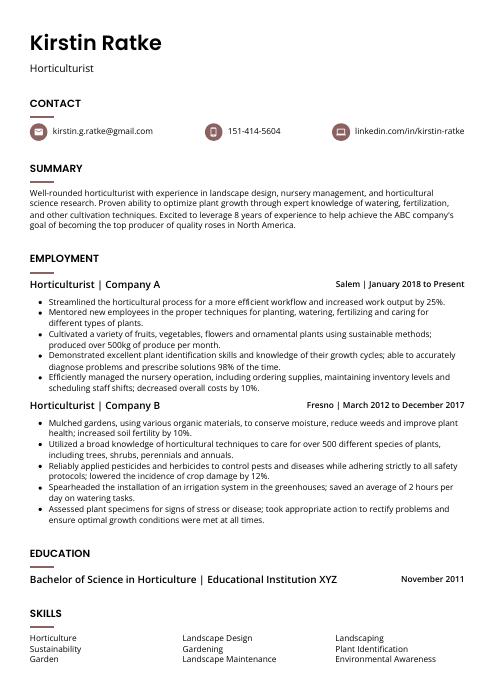 Fossa
Fossa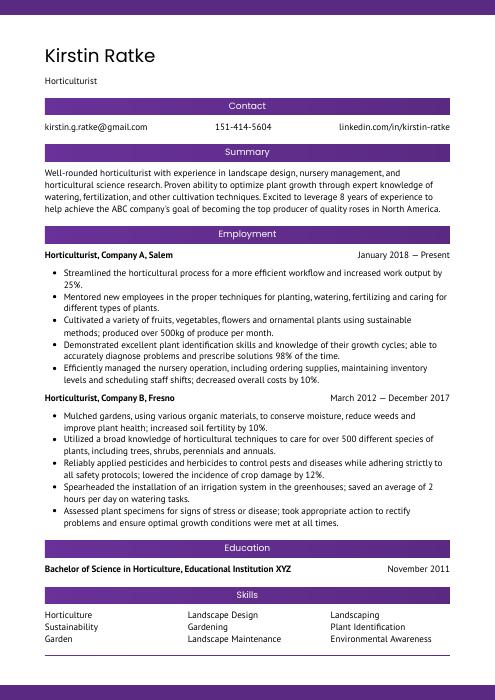 Jerboa
Jerboa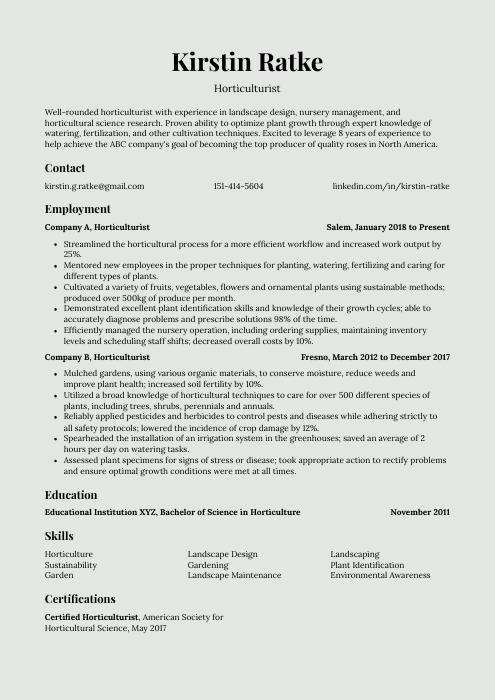 Saola
Saola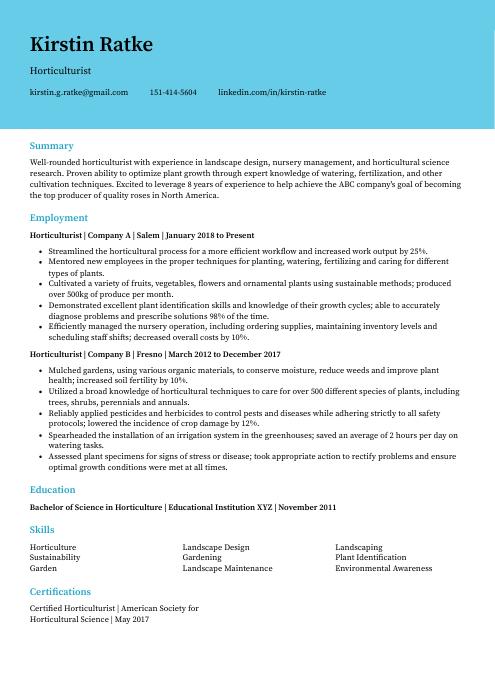 Dugong
Dugong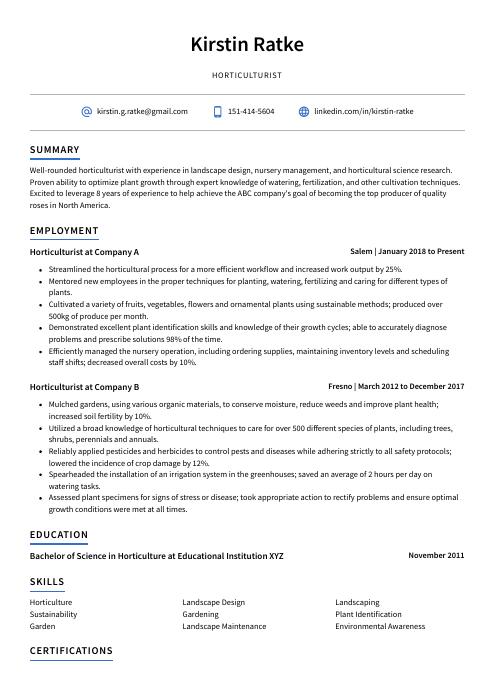 Axolotl
Axolotl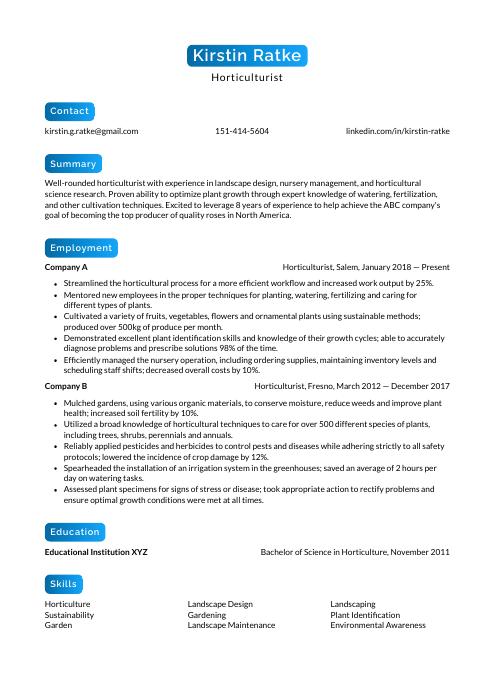 Kinkajou
Kinkajou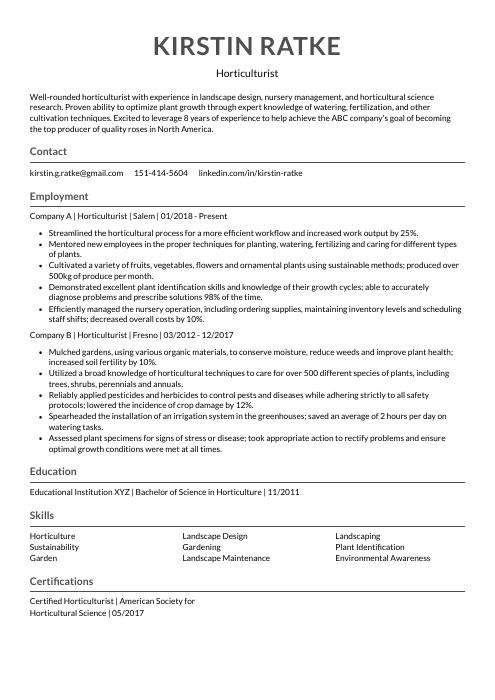 Indri
Indri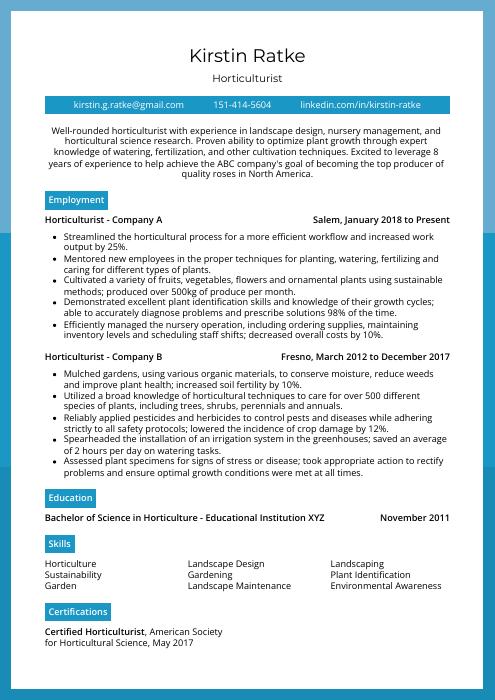 Rhea
Rhea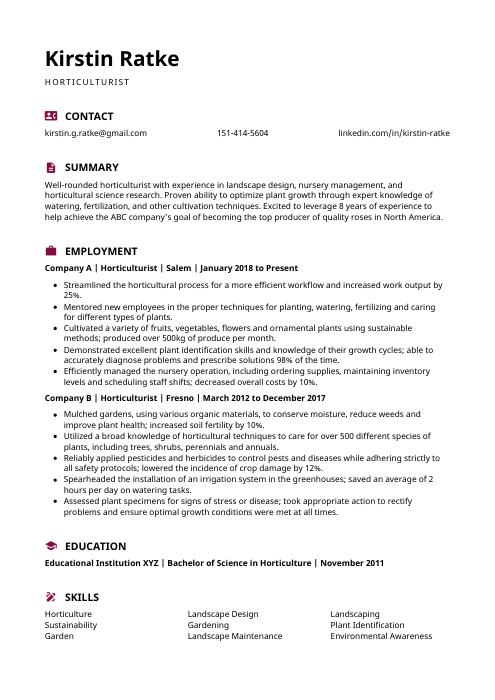 Hoopoe
Hoopoe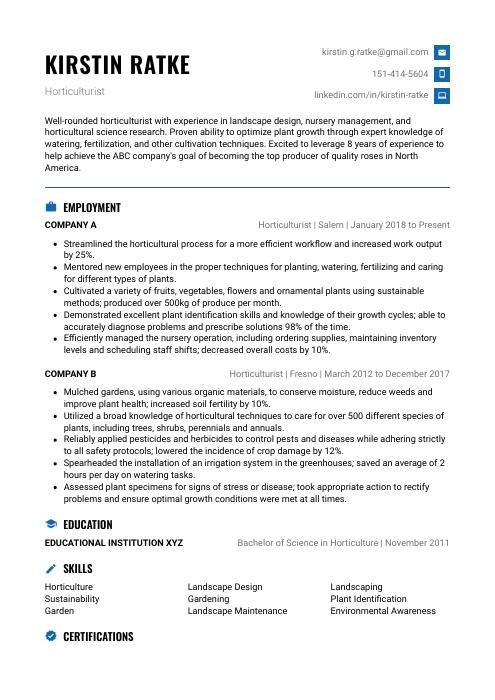 Echidna
Echidna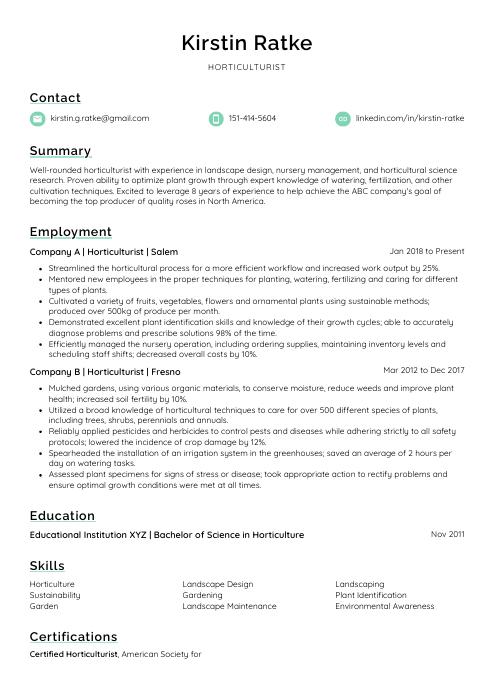 Lorikeet
Lorikeet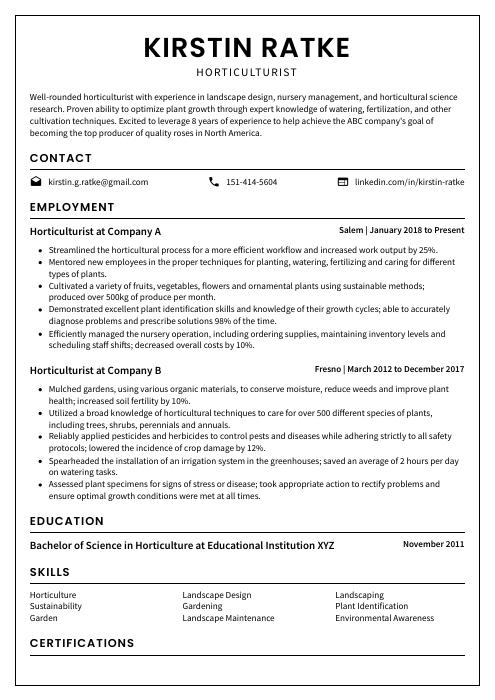 Cormorant
Cormorant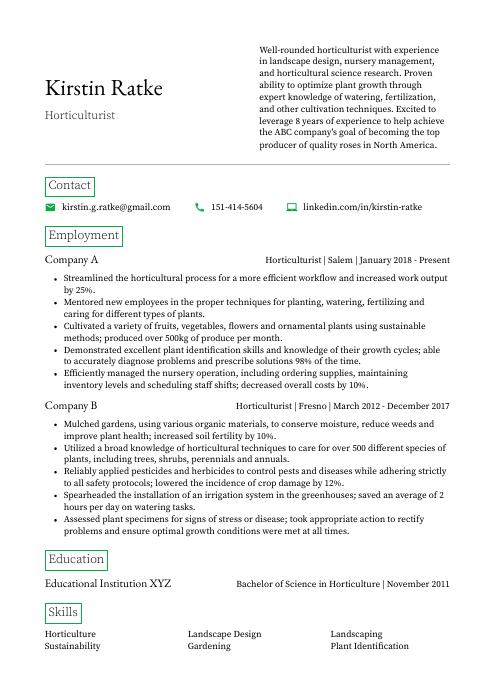 Quokka
Quokka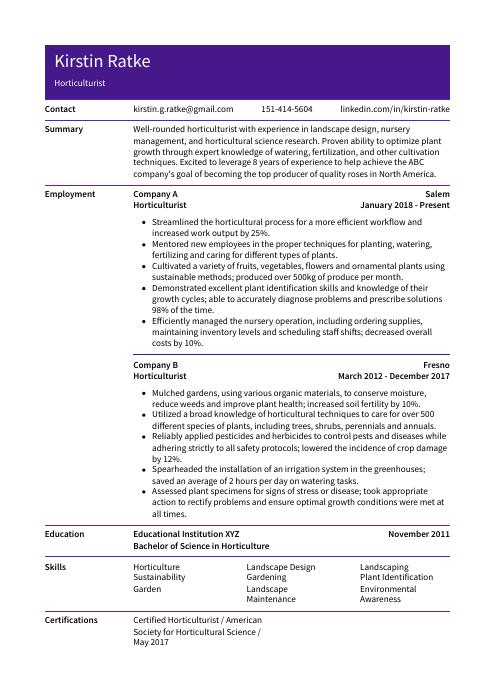 Pika
Pika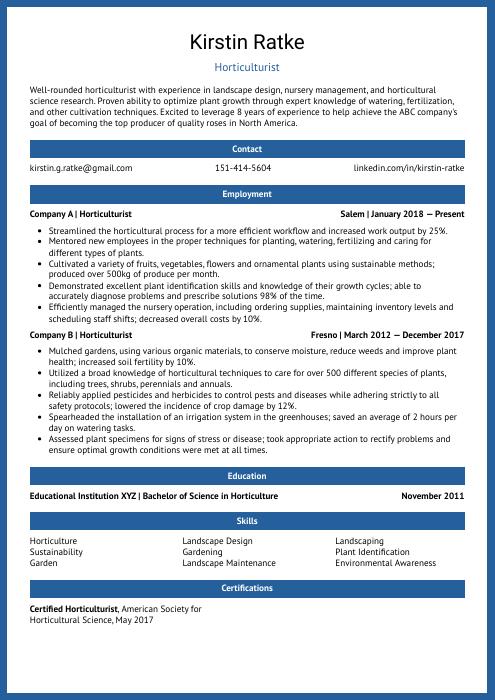 Ocelot
Ocelot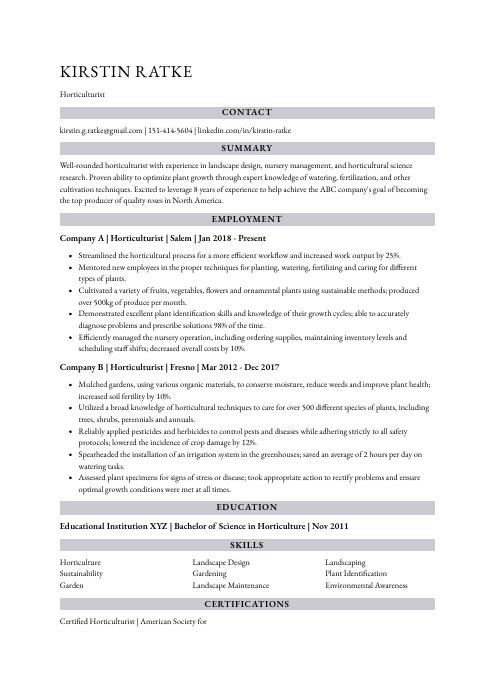 Numbat
Numbat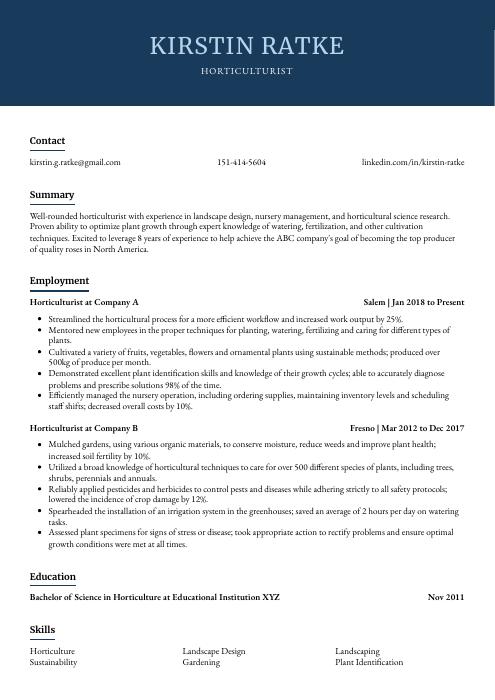 Bonobo
Bonobo Rezjumei
Rezjumei
